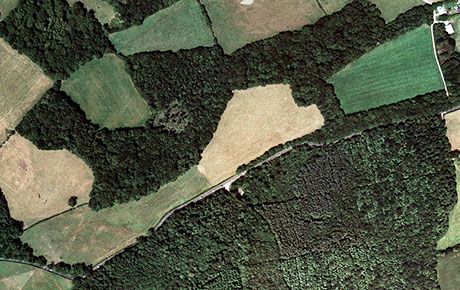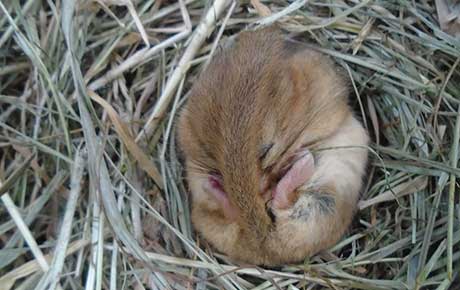Hazel dormice facts

Hazel dormice are small, native rodents with golden-brown fur, large black eyes and long whiskers. They are the only small British mammal with a furry tail. Dormice are active in late spring, summer and early autumn in the trees and shrubs canopy and they hibernate in nests on the ground over winter.
Dormice can be found in a variety of habitats and landscapes, particularly old managed woodlands linked by continuous hedgerows. Their long-term decline reflects the loss of many old woodlands over the last century, the lack of management of those that are left, and the removal and neglect of hedgerows no longer needed to enclose stock.
(Non-native fat or edible dormice are also present in Britain. They were introduced from Europe in 1908 and live in woods around Tring in Hertfordshire. These dormice can occupy houses and damage trees and can be a pest.)
Diet, behaviour and habitat

Hazel dormice rely on good tree and shrub diversity to provide them with food when they are active. They will feed on shrub flowers in spring, insects over summer and fruit and nuts in autumn. Their specialised diet isn’t available over winter, so they hibernate on the ground for about five months until spring.
Such a long hibernation reduces their active period and they generally produce only a single litter (although they may occasionally produce two litters) of four young, usually in August or September. On average dormice live for three years but they can live up to five years in the wild.
When hazel dormice are active, they are fully arboreal and nocturnal. Moving at night through the often poorly connected trees and shrub canopy can be challenging and so dormice don’t travel very far to feed and are relatively sedentary in their woodland homes. When they disperse as juveniles they need good tree, shrub and hedgerow connectivity within their home woodland or beyond it.
Download our dormouse fact sheet or see here for more information on dormouse ecology.
Dormice prefer the new growth of woody vegetation that arises after woodland management such as coppicing, ride widening, thinning or glade creation. In the UK, they tend to favour old coppice woodland but they’re also found in scrubland, old hedgerows and sometimes conifer plantations.
See more on woodland and hedgerow management for dormice.
Population and distribution

Hazel dormice used to be widespread in Britain but they have declined in both population and range over the past 100 years. In 2023 we published The State of Britain’s Dormice, based on our national monitoring records, which showed a population decline of 70% between 2000 and 2022.
Their range has shrunk significantly and they’re now confined predominantly to southern England and Wales. Even where dormice remain, their distribution is patchy.
See more on the declining extent of the hazel dormouse range and the efforts to restore them to their native areas.
Problems for hazel dormice
Dormice are thought to be declining because of:
- inappropriate or lack of long-term woodland and hedgerow management
- fragmentation of woodlands and hedges
- our variable maritime climate of warm winters and wet springs that sometimes leads dormice to wake frequently from hibernation and feed poorly in spring. This can affect their breeding success
See more on the problems facing dormice.

FAQs
Find out how to identify a dormice, how they open nuts, what to do if you think you’ve seen one by reading our frequently asked questions.





